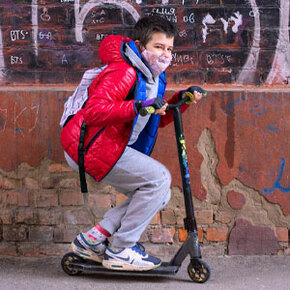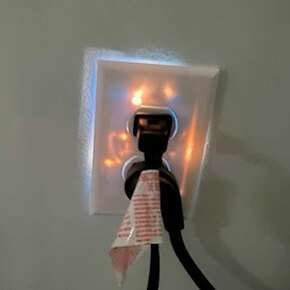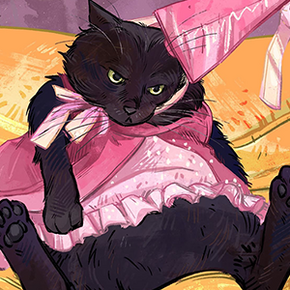
9 Mental Illnesses And Disorders Illustrated As Creepy Monsters
Sillvi is a Korean-born Canadian artist whose colorful anime-style illustrations we’ve featured back in May. This time, however, the artist is back with something a little more dark – he illustrated a handful of mental illnesses and disorders as creepy monsters and some of them are truly terrifying.
In a recent interview with Bored Panda, Sillvi said he doesn’t want to claim originality for the idea. “I’ve seen multiple artists depict mental illnesses as monsters. What motivated me to do my own version was because these depictions seemed to either romanticize or demonize the illnesses. Majority of them focused on manifesting some sort of monster that causes pain to their victims,” said the artist. He said his initial motivation was not to draw monters but rather to draw how they feel.
“My depictions are not perfect, and the experiences of those suffering from them can differ for each individual. I’ve made sure to include excerpts from credible sources on each illness I covered in the description of my Instagram posts,” added Sillvi. “The last thing I want is spreading misinformation.”
See the artist’s illustrations of mental illnesses and disorders as creepy monsters in the gallery below!
#1

Image source: sillvi illustrations
“Alzheimer’s disease is a progressive disorder that causes brain cells to waste away (degenerate) and die. Alzheimer’s disease is the most common cause of dementia — a continuous decline in thinking, behavioral and social skills that disrupts a person’s ability to function independently. -Mayo Clinic”
#2

Image source: sillvi illustrations
“Depression is a mood disorder that causes a persistent feeling of sadness and loss of interest. Also called major depressive disorder or clinical depression, it affects how you feel, think and behave and can lead to a variety of emotional and physical problems. You may have trouble doing normal day-to-day activities, and sometimes you may feel as if life isn’t worth living. -Mayo Clinic”
#3

Image source: sillvi illustrations
#4

Image source: sillvi illustrations
“Posttraumatic stress disorder (PTSD) is a psychiatric disorder that can occur in people who have experienced or witnessed a traumatic event such as a natural disaster, a serious accident, a terrorist act, war/combat, rape or other violent personal assault.
PTSD has been known by many names in the past, such as “shell shock” during the years of World War I and “combat fatigue” after World War II. But PTSD does not just happen to combat veterans. PTSD can occur in all people, in people of any ethnicity, nationality or culture, and any age. PTSD affects approximately 3.5 percent of U.S. adults, and an estimated one in 11 people will be diagnosed PTSD in their lifetime. Women are twice as likely as men to have PTSD.
People with PTSD have intense, disturbing thoughts and feelings related to their experience that last long after the traumatic event has ended. They may relive the event through flashbacks or nightmares; they may feel sadness, fear or anger; and they may feel detached or estranged from other people. People with PTSD may avoid situations or people that remind them of the traumatic event, and they may have strong negative reactions to something as ordinary as a loud noise or an accidental touch.
(DSM-5)”
#5

Image source: sillvi illustrations
“Bipolar disorders are brain disorders that cause changes in a person’s mood, energy and ability to function. Bipolar disorder is a category that includes three different conditions — bipolar I, bipolar II and cyclothymic disorder.
People with bipolar disorders have extreme and intense emotional states that occur at distinct times, called mood episodes. These mood episodes are categorized as manic, hypomanic or depressive. People with bipolar disorders generally have periods of normal mood as well. Bipolar disorders can be treated, and people with these illnesses can lead full and productive lives. (American Psychiatric Association)”
#6

Image source: sillvi illustrations
“Attention-deficit/hyperactivity disorder (ADHD) is one of the most common mental disorders affecting children. ADHD also affects many adults. Symptoms of ADHD include inattention (not being able to keep focus), hyperactivity (excess movement that is not fitting to the setting) and impulsivity (hasty acts that occur in the moment without thought).
An estimated 8.4 percent of children and 2.5 percent of adults have ADHD. ADHD is often first identified in school-aged children when it leads to disruption in the classroom or problems with schoolwork. It can also affect adults. It is more common among boys than girls. (American Psychiatric Association)”
#7

Image source: sillvi illustrations
“Anorexia (an-o-REK-see-uh) nervosa — often simply called anorexia — is an eating disorder characterized by an abnormally low body weight, an intense fear of gaining weight and a distorted perception of weight. People with anorexia place a high value on controlling their weight and shape, using extreme efforts that tend to significantly interfere with their lives.
To prevent weight gain or to continue losing weight, people with anorexia usually severely restrict the amount of food they eat. They may control calorie intake by vomiting after eating or by misusing laxatives, diet aids, diuretics or enemas. They may also try to lose weight by exercising excessively. No matter how much weight is lost, the person continues to fear weight gain.
Anorexia isn’t really about food. It’s an extremely unhealthy and sometimes life-threatening way to try to cope with emotional problems. When you have anorexia, you often equate thinness with self-worth.
Anorexia, like other eating disorders, can take over your life and can be very difficult to overcome. But with treatment, you can gain a better sense of who you are, return to healthier eating habits and reverse some of anorexia’s serious complications. (Mayo Clinic)”
#8

Image source: sillvi illustrations
“Obsessive-compulsive disorder (OCD) is an anxiety disorder in which time people have recurring, unwanted thoughts, ideas or sensations (obsessions) that make them feel driven to do something repetitively (compulsions). The repetitive behaviors, such as hand washing, checking on things or cleaning, can significantly interfere with a person’s daily activities and social interactions.
Many people have focused thoughts or repeated behaviors. But these do not disrupt daily life and may add structure or make tasks easier. For people with OCD, thoughts are persistent and unwanted routines and behaviors are rigid and not doing them causes great distress. Many people with OCD know or suspect their obsessions are not true; others may think they could be true (known as poor insight). Even if they know their obsessions are not true, people with OCD have a hard time keeping their focus off the obsessions or stopping the compulsive actions. -American Psychiatric Association”
#9

Image source: sillvi illustrations
“Antisocial personality disorder: a pattern of disregarding or violating the rights of others. A person with antisocial personality disorder may not conform to social norms, may repeatedly lie or deceive others, or may act impulsively. – American Psychiatric Association
Antisocial personality disorder, sometimes called sociopathy, is a mental condition in which a person consistently shows no regard for right and wrong and ignores the rights and feelings of others. People with antisocial personality disorder tend to antagonize, manipulate or treat others harshly or with callous indifference. They show no guilt or remorse for their behavior.
Individuals with antisocial personality disorder often violate the law, becoming criminals. They may lie, behave violently or impulsively, and have problems with drug and alcohol use. Because of these characteristics, people with this disorder typically can’t fulfill responsibilities related to family, work or school. – Mayo Clinic”


















Got wisdom to pour?
My depictions are not perfect, and the experiences of those suffering from them can differ for each individual.
I recently came across a fascinating article where 25 people shared their best money-saving hacks, providing practical tips for financial management. Intrigued by their advice, I began exploring additional ways to maximize my savings and investments. Websites like https://icoholder.com/en/icos/ongoing have become my go-to resource, offering valuable insights into ongoing ICOs, allowing me to diversify my investment portfolio wisely.
Hello! I grew up feeling so ashamed of who I was, and had a lot of external people telling me that I was chubby, silly, uncoordinated, but mostly silly. I was very unsure of myself. Since I signing up with this online https://us.calmerry.com/blog/relationships/how-often-do-couples-in-long-term-relationships-have-sex/ company, now I feel so much more hopeful for the best future!